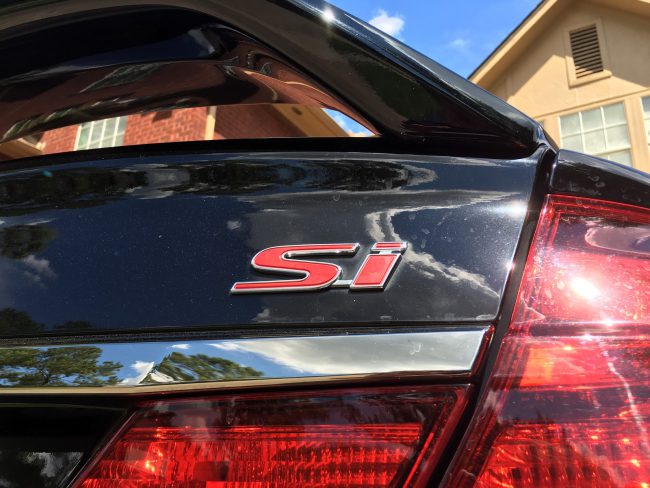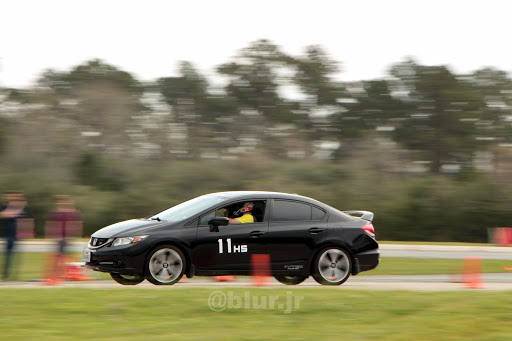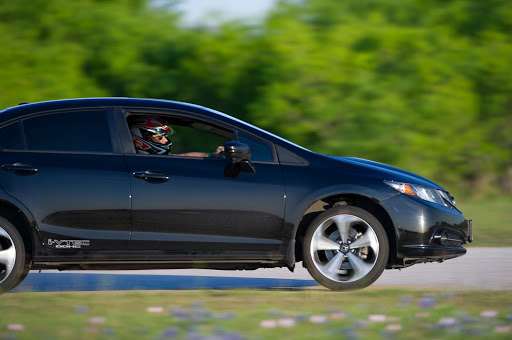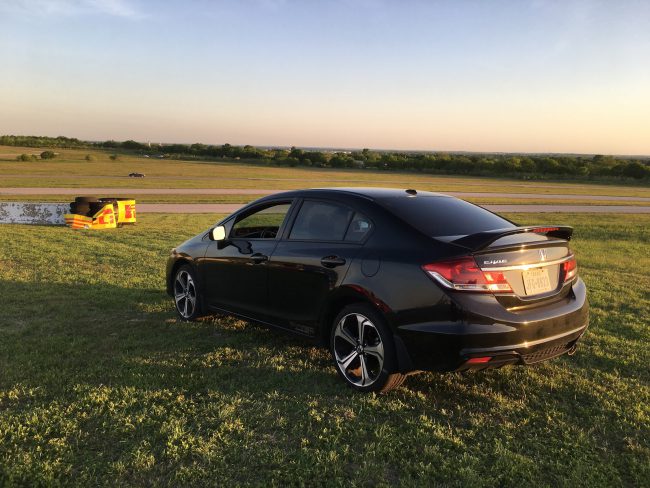
I didn’t know it was going to be the last ride of my ill-advised, midlife return to motocross, but that’s the thing about last rides – they don’t care about your plans. I had a long second over the finish line jump to ponder the fact that no part of my body was connected to my KTM, and that my children are likely to still need me around for a while longer. Why the hell am I doing this? My body survived the landing, but my hobby did not. I’d been riding beyond my diminishing abilities, and the risk was no longer acceptable.
The bike was gone after a quick wash and Craigslist ad, but the void that only speed and competition could fill remained. I’d been wanting to try autocross and track driving, but my Ford Flex wasn’t welcome at either. My girlfriend graciously offered to drive my dad-mobile so I could get a suitable sports car; it should come as no surprise she is now my wife. But I needed more than a track car, this was going to be my daily driver and kid hauler. I needed something that could do it all, and for about $20,000 used.
I came up with a short list of contenders: Ford Focus ST, Honda Civic Si, Lexus IS 250 (previous generation), and Subaru BRZ — because I forgot my kids have legs for a minute. Our friendly neighborhood used car megastore, Texas Direct Auto, had them all. I arranged to drive them back to back, in that order, and settled in for an evening of tough decisions. Except… there was no third test drive. About 5 minutes into my half hour of alone time with the Civic, front tires smoking in 2nd gear, I was completely hooked. This car was fiendishly fun to drive, like nothing I’ve felt since the first time a 2 stroke engine hit the powerband underneath me over 3 decades ago.
Avid consumers of automotive commentary know the 9th generation is the least loved Civic. Maybe the pre-refresh models were disappointing. Maybe it was a hapless victim of “the wobble.” After 18 months and 25,000 miles with my 2014 sedan, however, I’m here to tell you it stands on its own merits. I’ll also try to convince you it is the last example of an honest, simple, affordable sports car, the likes of which we probably won’t see again.
Let’s start with power. The engine is the heart and soul of any sporting car, the Si’s 2.4 litres of naturally aspirated fury especially so. This is no low-pressure turbo, direct-injected clatterbox. The high revving VTEC is Honda’s love song heavy metal power ballad to the enthusiast, and it possesses the vocal range of Rob Halford. By that I mean it works well enough down low, but you’re best served screaming for vengeance at 7000 RPM.
Despite how much it encourages and rewards you to drive it hard, that furious roar is scaled down to manageable proportions that’s more feisty housecat than wild panther. It has all the features of an apex predator, but it probably won’t kill you – and therein lies the true magic of the Si. You can approach the limits of both the car and your own skills every time you drive without getting in trouble. Much.
In other words, you can practice your racecraft in otherwise normal everyday driving. Taking the kids to school? Zip through gears and across lanes until you feel like Baby Driver; try not to notice you’re just sort of keeping pace with the Tahoes and Siennas. Give the crossing guard a nod like you’re checking in with a flag station. Stuck in traffic? Practice squeeze and ease, work on situational awareness, and if there is a gap you will take it before anybody else looks up from their phone. Clear road with some curves? Let the VTEC sing like the supercharger on Max’s Pursuit Special while you master braking, turn in, apex, and track out.
There’s more to the Si than a great engine though. Other manufactures just put more power in a compact FWD and call it done. It’s the rest of the details that really make this car stand out, and I commend Honda for sweating them. First and foremost, there is an honest to goodness, mechanical limited slip differential to put the power to the ground. You can get on the gas sooner out of every turn, without a phony e-diff system overheating the brakes (you’ll be doing that all on your own soon enough). I’ve never detected torque steer, although it will happily spin the front wheels if you combine too much steering and throttle, which you definitely should not do. The Si also gets larger diameter stabilizer bars front and rear compared to its more civic-minded brethren.

Photo courtesy of Gabriel Rodriguez Jr.
When you’ve had enough “wax on, wax off, paint the fence” on your daily commute, starting your motorsports career is as easy as showing up at the nearest autocross with a little extra air in the front tires. No other modifications are necessary at the novice level. Don’t worry about shifting, 2nd gear is good for 53 MPH before the rev limiter kicks in. I’ve only needed third once, and I’m not convinced I gained any time from using it. The cockpit is overflowing with information about the car’s current status on no fewer than 4 screens. Turn off all the ones you can, ignore the rest, and just focus on driving and listening to your instructor. You may not be competitive in H Street right away, but that depends on the state of your skills and, honestly, if any CRXes or Fiesta STs show up. There are vast differences in power and weight in HS, but I digress. By the time you’ve burned up the stock tires, after about one season, fit some 200 treadwear replacements and podiums are within reach. Even with my less-than-the-best Continental Extreme Contact Sports I was only 0.2 seconds off 1st place at my last event. You know it’s a good run when long forgotten french fries slide out from under the seats.
If you’re like me, autocross will soon lead to track days. I mean this literally; the SCCA autocross school I attended came with a free admission to a Track Night in America event. I recommend both without reservation. Before you get to the paddock you will definitely need to swap out the brake pads and fluid with suitable high temperature replacements. I didn’t and came back from Harris Hill in San Marcos with scorched rotors, melted pads, and a smile that lasted a week.
At a trackday, as opposed to an autocross, you will definitely be shifting gears and monitoring the car’s condition. I’d like to tell you all those fancy gauges will help you here, but despite having a giant tachometer with a clearly marked redline, VTEC indicator lights that go from red (just kicking in) to, um, also red (shift now!), and an engine power level gauge (shift at 100%), it is trivially easy to over rev because the engine Just. Keeps. Pulling. Even in 3rd gear the redline comes fast and furious; the power doesn’t drop off. I’ve hit the rev limiter so many times it’s filed a restraining order. You just have to learn the sound of the engine and shift when the pitch is just right.
The one instrument they absolutely got right is the speedometer, placed at the highest possible location, dead center over the steering wheel, showing your speed in large, friendly numbers. This is important because corner entry speed is something I’m still struggling with as a novice, and the car really inspires confidence, sometimes a little too much. For example, the difference between entering Harris Hill’s turn 6 at 80 v. 83 is the difference between totally fine v. making a trip through the salad bar if you don’t catch this 4 wheel slide. If you overcook an entry, all it usually takes to settle the car is unwind a bit and ease up gently on the throttle. Predictable understeer is your friend. If I have one gripe about its track worthiness it’s that the gas and brake pedals are a bit too far apart for me to heel-toe easily, even in size 13 Johnston and Murphys.

Turn 6
If all you need the car for is spirited driving and track days on a budget, the Miata and Toyobaru twins are probably better suited. If you need your car to actually do car stuff with, like carrying people and groceries, the Si Sedan is a completely livable dual-purpose machine.
The biggest surprise is how much usable interior space there is. At 5’ 11 ¾ “, and the front seat adjusted for my normal driving position (which is probably a bit more upright than most), I can easily sit behind myself in the back seat. “Compact” doesn’t mean what it used to. My head is pretty close to the headliner though, so much that with my helmet on I have to open the sunroof shade and stick my head through it. My teenage boys with their backpacks and instrument cases (flute and alto saxophone) fit in the back seats just fine for the morning trip to school. A week’s worth of groceries for my family of 6 will fit (tightly) in the trunk, as will my 10×10 folding canopy and plus-sized camping chair that I take to the track.
It is reasonably economical, despite the recommended diet of premium fuel. It gets a reported 26 MPG on my 17 mile, hard-driving, stop-and-go commute from the suburbs into downtown Houston. Cruising to the track on the interstate at 80 it gets 32 MPG. Note that I said interstate, not freeway, because freeways in Houston are only free if your time is worth nothing. I do wish the range was a bit longer. On a full tank the infotainment system indicates a hilariously optimistic 420 miles to empty, but I’ve never gone more than about 240 before the low fuel warning. I’ve also never put more than 10 gallons into the allegedly 13 gallon tank. Mathematically minded readers will note that works out to 24, not 26 MPG, and they are correct – it’s always 2 lower when I calculate it.
Do I have anything else to complain about? It is a bit loud inside, especially when fitted with sticky tires. The styling is a bit much for a middle aged, overweight white man, or at least I thought so until I saw the new Type R. The clutch engagement point is high and abrupt. Audio quality is merely adequate. It is my God-given right to finish listening to the current song before starting or ending the work day, but killing the engine shuts everything off. It takes 30 seconds or more for Bluetooth to connect. I use this time to observe a moment of silence for the era when you could effortlessly adjust the bass, treble, and volume without taking your eyes off the road, with actual knobs. Then the song I didn’t get to finish the day before comes on at full volume, traumatizing my sleepy children.
Other than these minor grievances, I am a very satisfied owner. I’ve had no mechanical issues other than regular maintenance and consumables. It still feels as solid as it did the day I brought it home, with no squeaks, leaks, or rattles. The cloth seats are holding their own against my indifferent offspring. I employ a standard measurement for my satisfaction with any major purchase, and it is simply this – if I had to replace it tomorrow, would I buy it again? Yes I would, without hesitation, and that brings me to my final point and why I consider this car to be the last example of something very special.
The problem is, I’m not replacing this car tomorrow. I’m replacing it in 2 years when my son turns 16 and I pass it down to him. What will I replace it with? My criteria really won’t have changed. As far as I can tell, this car stands alone at the center of the Venn diagram of simplicity (read: naturally aspirated, manual transmission), performance, light weight, practicality, and affordability. Or rather stood, because Honda doesn’t make them like that anymore, and neither does anybody else. We’ve seen the future, and it’s turbos all the way down. Remove any one of those requirements and options emerge, but I don’t think there is, or will be, another car on sale today or tomorrow that hits the sweet spot so well.


What an extremely well written piece. I’m a big fan of VTEC owning both a VFR and an Acura TL and agree with you in lamenting the passing of the naturally aspirated stratospheric revving Hondas. I’ve always found turbos suspect and bought a 5.0 Mustang over a Saab turbo as my first new car way back in the ’80s partially for that reason. That old 5.0 was pure unadulterated honest power without any forced aspiration techno trickery. Just the way God meant it to be.
Thanks G! We’re going to miss them when they’re gone.
Turbos are awesome!
Done well you get minimal lag and a big fat powerband,
Done poorly (like most people remember from the 80s and they suck.
I daily drive a heavily modified 240SX with a smallish turbo, 325 HP, 350 torque, manual transmission, RWD, 2700 lbs makes for a fun car.
I think the 240SX was the spiritual successor to the original Z cars, more so than the current Z. I looked for a clean SX but all I found were basket cases and drift cars.
Fun Fact: the S14 was never sold in Hawaii as a new car. Right after the Fast and the Furious the differential between the private party value of a clean midwest car and what someone was willing to pay sight unseen in Hawaii was enough even after shipping to make it a great side job.
If I wrote as cleanly as the author of this post, I would have worked the word arbitrage into the above paragraph without it sounding incredibly awkward. Good job!
Thanks!
Brings memories of my Integra GS-R. Thank you for writing this.
The answer to your conundrum is obviously not to give the Civic to your son. Instead, get him some turbo (I like to think of them as diesels, due to their power band) hybrid eco-wheezer with government-controller speed limiter (you said in two years). Cruel? Yes. But children should have something to aspire to, and what better thing to aspire to than a naturally-aspirated VTEC engine.
Tempting! I might just buy a 2016 coupe, truly the last, in a color that’s sure to get me speeding tickets.
Wonder if the answer of what to replace it with might be to go a size and paygrade smaller with something like a Mirage or Chevy Spark. Stick, small NA high reving engines with money leftover for having the engine chipped, fartcanned and aggressive tires. The Corvette talk around here lately comes down to weight and the above choices would be 300-400 pounds lighter than your Civic with 4-5 doors and similar useful room.
Something more like you had might be the Mazda 3. Compacts having gotten so big though it is almost like they are just recreating old Quad 4 Grand Ams. except heavier.
If I went smaller, I would take a hard look at a Fit.
As a Toyabaru owner with kids I’m a bit jealous. I absolutely love how the FR-S drives, but the practicality sucks.
I think Toyota made a mistake making the car a low slung coupe… The AE86 wasn’t a sports car, why did they have to make the Toyabaru as practical as a 2000GT?
Agreed. I wish they would make a proper successor to the Celica instead of a halo Supra that 5 people will buy.
ditto. A proper hatch with fold down seats would do wonders, and maybe even ditching the rears entirely. Two seaters were significantly more expensive to insure at one point vs 2+2s.
There is a whole lotta “last of the” happening in the automotive world right now.
Glad you had fun at track night. I was there as well, in the green 993 with gold wheels. It was a good event, but I was not expecting the track to be so damn bumpy. Made TWS feel like a velvet carpet.
Especially the straight with the big hill at the end. Too bad TWS is gone.
Nice written!
I’m a VTEC lover/ victim too.
Wish you alot of lovely trackday’s sessions with your daily/track car.
I love that spirit.
I’ve had my 2007 Civic Si sedan for eleven years now and feel roughly the same. I’ve had company cars much of that time, so the Civic has less than 60,000 miles. I sometimes wish that I’d grabbed one of the last N/A Si sedans, just to put off being without one a few more years. The basket-handle wing and 18 inch tires seemed a bit too much for me at the time. If only I could have had a glimpse at a Type-R.
Welcome, and nice piece.
Teenage self says: Bruce Dickinson > Halford
/horns
I can’t argue with that, I just wanted to throw in screaming for vengeance.
My old TL Type S had an LSD and I think it handled Chicago snow almost as easily as a dumb SUV.
And now from the nanny state labs at Bosch:
http://www.foxnews.com/auto/2018/05/22/air-jets-on-motorcycles-could-prevent-crashes.html
What is Robert Harris’s day job? Send this article to the hack reviewers at Jalopnik (and TTAC for that matter). Maybe they’ll learn a thing or two.
I’m allegedly a software developer, but at this point my duties are mostly ceremonial.
I enjoyed it.
As the previous owner of two Integra Type Rs, and a slew of other Honda branded conveyances, I agree with your VTEC appreciation. I don’t think that I could own your particular Si without at least doing a Type R head swap and a retune with some basic mods. The K24 in that particular model wasn’t set to boil quite as readily as other K-Series brethren in the Honda lineup, but it shares enough parts to get their pretty easily, all with Honda factory components.
What’s funny is that these older models have much of what all current cars are sadly defunct of, fun. There is something to be said for cars that vibrate and scream when pushed hard, even if that push doesn’t equal a whole lot of shove.
The unabashed VQ-enthusiast in me struggles to stomach your VTEC praise, but this was a great piece. I hope you find yourself in a truly powerful, naturally-aspirated, RWD Nissan next. 😀
Thanks Eric, I wouldn’t mind that at all. My mother drove a 280z when I was at an impressionable age. Since then I’ve owned 6 Nissans, two of them VQ powered – a G35 and, um, a Quest.